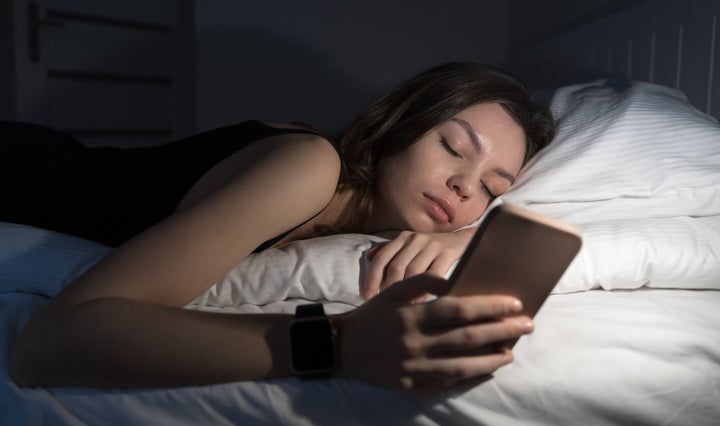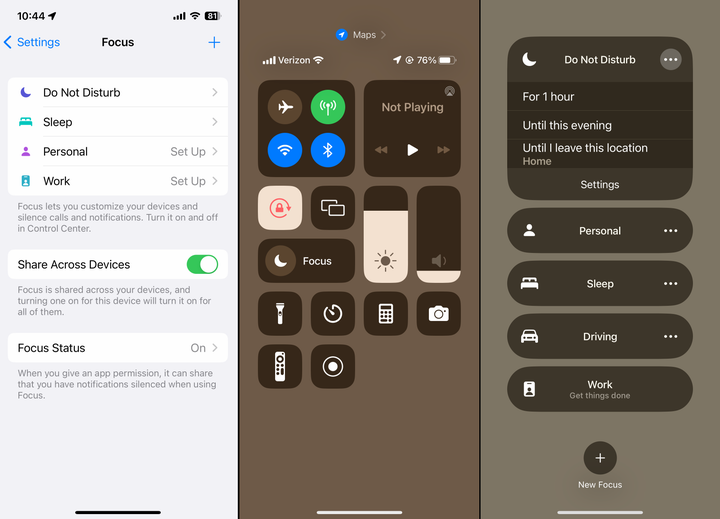
Apple’s “Do Not Disturb” function was first introduced in 2012 and has become a popular feature. Gone are the days you’d automatically be woken up by the annoying buzz from a call or text, or really any sort of noisy notification.
Still, not everyone sees the feature as beneficial, such as people who are on call for work or need to be reached during late hours. People who do use DND mode might assume others use it, too, and that their off-hours texts won’t be disruptive — but of course, that isn’t always the case. And when someone isn’t using DND, being bombarded with buzzing from all sorts of notifications can disrupt their sleep. Who wants that?
I’ve used Do Not Disturb every night when I go to sleep. My iPhone notifications (calls, texts, apps, emails, etc.) are all silenced and hidden until I manually turn off DND in the morning, and this setting doesn’t affect any alarms I set.
But a longtime rule of thumb still holds that any work-related notifications should be sent before 9 p.m.; experts generally deem that anything sent after that is rude if you’re not a close friend or immediate family member. And even when you are a close friend or family member, some people feel the message should be pretty darn important if they’re likely to be asleep already.
“As a general rule, you shouldn’t text somebody after 9 p.m. It may be seen as an intrusion of privacy, or they may feel you’re inserting a sense of urgency that doesn’t need to be there,” Scott Steinberg, author of “Netiquette Essentials: New Rules For Minding Your Manners in a Digital World,” told Southern Living. “As for the morning, if school hasn’t started and you wouldn’t expect the person to be at work, it’s best to wait. Or, if you send the message, expect that you may not get a response right away.”
However, 20-somethings in particular tend to stay up quite late, according to one study of smartwatch users, and might not mind hearing from their friends after 9 p.m. It can seem like everyone is living by different rules.
“People want to relax, watch their favorite Netflix show and sleep! A late-night email or text requires a good reason.”
- Diane Gottsman, The Protocol School of Texas
“I’ll turn on ‘DND’ if I don’t want to be bothered, but it’s usually something specific, like a movie or dinner,” said 40-something iPhone user Sam Humphries of his texting habits. “It depends what the relationship is, but if we have familiarity, 24/7. My siblings, I would text whenever. My mom, probably between 8 a.m. and 8 p.m. her time.”
An etiquette expert suggests setting boundaries that consider the other person.
“Late-night texts and emails are for emergencies only. A business email should be sent during the day, or at least let the person know their response is not necessary until the next work day,” said Diane Gottsman, who runs The Protocol School of Texas. “Put it in the subject line, ‘For Friday’s attention,’ so they know the evening text on Thursday is intended for the next day. Better still, wait to email, because [such a text] puts pressure on the person you are communicating with.”
Sometimes, messages might be going to someone in another time zone, and that’s something to be aware of.
“Also, you can schedule an email for the next day for delayed delivery,” Gottsman added. “You can compose your email while you are thinking about it, but send it the next day. Take into consideration other time zones, both in the U.S. and in other countries.”
So, is it always rude to text during late night hours, even with the existence of Do Not Disturb?
It really depends, but — sort of. Responses vary from person to person, but there’s a high probability that if the person you’re texting is asleep, and if it’s not a startling emergency, it’s best to save that message for the morning.
“Texting a friend late at night, if you need a shoulder to cry on, is acceptable on a rare occasion, but don’t make it a habit. People want to relax, watch their favorite Netflix show and sleep!” Gottsman said. “A late-night email or text requires a good reason.”
You don’t know whose Do Not Disturb is on. It’s just not worth the risk.
If people text you at all hours, here’s how to enable your iPhone’s Do Not Disturb.

Do Not Disturb can be used two different ways:
- By manually turning it on whenever you want to limit communication;
- By setting an automatic schedule for it to turn on at a set time of the day, such as your usual bedtime.
From your iPhone’s control center, choose the “Focus” button. You can also enter your phone’s settings and choose “Focus.”
Apple offers a few specific focus settings for Do Not Disturb for users who have iOS 15 and higher. (If you don’t automatically see these options listed, go to “Settings,” then “Focus,” then hit the plus sign in the upper-right corner to choose from a menu of options.)
- Standard Do Not Disturb: When selected from the Control Center, you can quickly choose duration options such as “for one hour,” “until this evening” or “until I leave this location.”
- Driving: You can choose whether it connects automatically or manually to your car’s Bluetooth. It allows a customizable reply message to be sent to selected contacts to tell them you’re driving.
- Sleep mode: This allows you to schedule specific hours during which you do not want your sleep interrupted.
- Personal: This can be used for whatever specifics you need and offers “Smart Activation,” which can automatically turn this mode on based on a schedule, location and/or app use. Mac Rumors gives this example: “If... you usually study with the Books app, in the library, immediately after lunch on weekdays, Smart Activation can learn your routine and intelligently activate the Focus mode you made without you having to do anything.”
- Work: Similar to the other modes, you can choose specific people and apps you still want to receive notifications from, such as your boss or other critical contacts.
In the “Contacts” section of “Settings,” there is also a permission titled “Emergency Bypass” that allows you to choose to receive rings and vibrations from certain people while any Do Not Disturb is enabled.
When DND is on, you’ll see a crescent moon symbol on your lock screen. Other iPhone users will be able to tell that your Do Not Disturb is turned on when they open Messages to text you.
Finally, the Focus page includes a toggle setting so you can share your specific Focus and Do Not Disturb settings across your other connected Apple devices. For example, if you turn your phone to DND with this enabled, your laptop will follow suit.
You can enable Do Not Disturb on Android products, too.
Android products also have a Do Not Disturb option.
To turn it on, open the Settings app, then scroll down and click “Sound & Vibration.” Tap “Do Not Disturb” and click “Turn On Now.”
By scrolling down in the Do Not Disturb setting, you can choose varied modes by tapping “Schedules.” These can be set to a specific schedule.
- Sleeping: Mute notifications while asleep.
- Event: Mute notifications during scheduled events.
- Gaming: Mute notifications while playing phone games.
- Driving: Mute notifications when your phone detects you’re driving.
Android users can also turn on Do Not Disturb by swiping down from the top of their screen and pushing the button.
